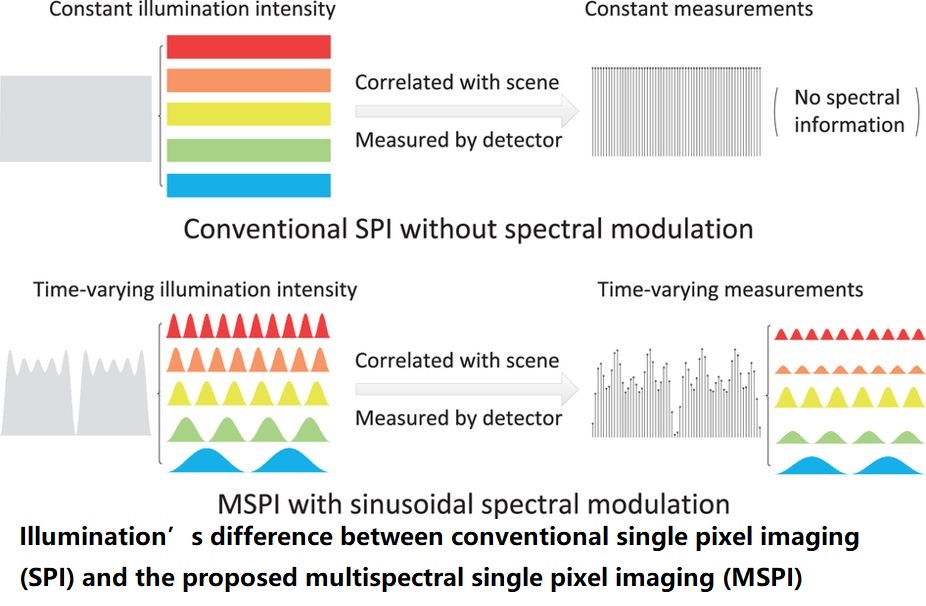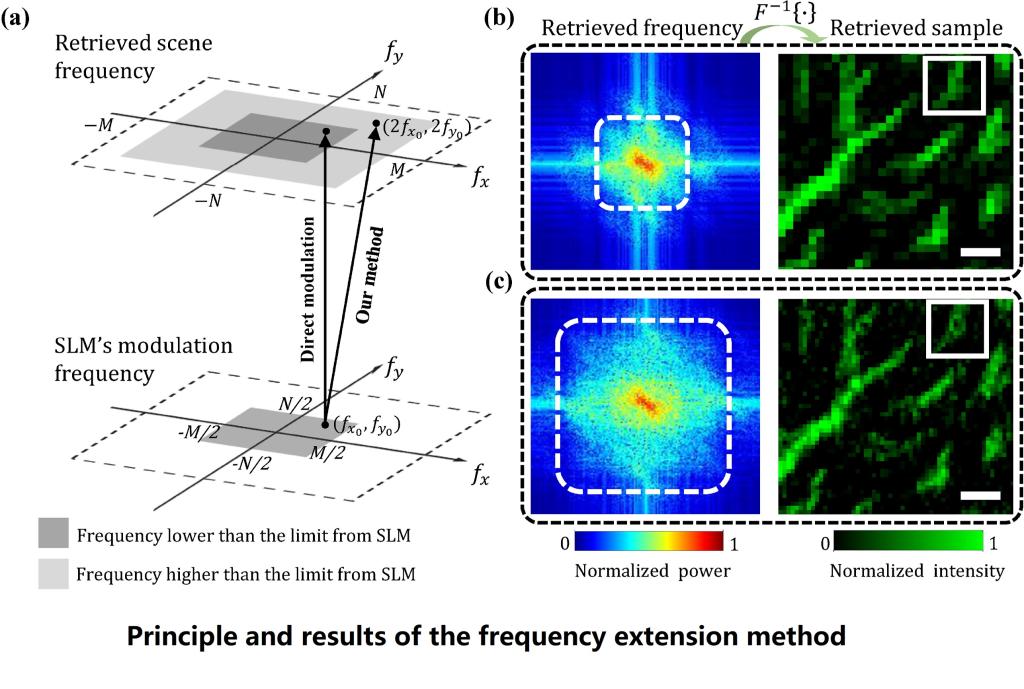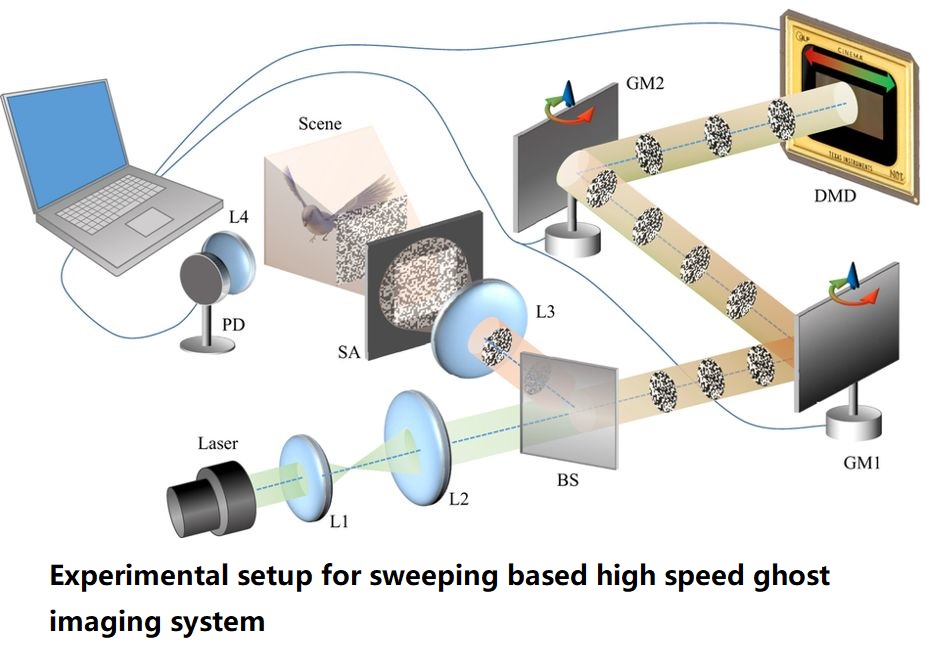Single pixel imaging
Introduction
Single-pixel imaging (SPI) is an emerging imaging technique that reconstructs the target 2D or 3D visual information from a number of 1D encoded measurements. It uses a low-cost single-pixel detector to capture light, and then retrieves scene’s image computationally. The simplification of the sensing device expands the imaging system’s spectrum, which enables SPI to work at the wavelength bands where array sensors are costly or unavailable, such as infrared and terahertz. Besides, SPI attracts a lot of attention in imaging through scattering media because of its high tolerance to distortion between samples and detectors, and in photo-counting imaging because of its high signal-to-noise ratio.
Highlights
Multispectral imaging using a single bucket detector
Existing multispectral imagers mostly use available array sensors to separately measure 2D data slices in a 3D spatial-spectral data cube. Thus they suffer from low photon efficiency, limited spectrum range and high cost. To address these issues, we propose to conduct multispectral imaging using a single bucket detector, to take full advantage of its high sensitivity, wide spectrum range, low cost, small size and light weight. Technically, utilizing the detector’s fast response, a scene’s 3D spatial-spectral information is multiplexed into a dense 1D measurement sequence and then demultiplexed computationally under the single pixel imaging scheme. A proof-of-concept setup is built to capture multispectral data of 64 pixels × 64 pixels × 10 wavelength bands ranging from 450 nm to 650 nm, with the acquisition time being 1 minute. The imaging scheme holds great potentials for various low light and airborne applications, and can be easily manufactured as production-volume portable multispectral imagers.
Bian, L., Suo, J., Situ, G., Li, Z., Fan, J., Chen, F., & Dai, Q. (2016). Multispectral imaging using a single bucket detector. Scientific reports, 6, 24752.

Doubling the pixel count limitation of single-pixel imaging via sinusoidal amplitude modulation
We demonstrate a single-pixel imaging (SPI) method that can achieve pixel resolution beyond the physical limitation of the spatial light modulator (SLM), by adopting sinusoidal amplitude modulation and frequency filtering. Through light field analysis, we observe that the induced intensity with a squared value of the amplitude contains higher frequency components. By filtering out the zero frequency of the sinusoidal amplitude in the Fourier domain, we can separate out the higher frequency components, which enables SPI with higher resolving ability and thus beyond the limitation of the SLM. Further, to address the speed issue in grayscale spatial light modulation, we propose a fast implementation scheme with tens-of-kilohertz refresh rate. Specifically, we use a digital micromirror device (DMD) working at the full frame rate to conduct binarized sinusoidal patterning in the spatial domain and pinhole filtering eliminating the binarization error in the Fourier domain. For experimental validation, we build a single-pixel microscope to retrieve 1200 1200-pixel images via a sub-megapixel DMD, and the setup achieves comparable performance to array sensor microscopy and provides additional sectioning ability.
Zhang, Y., Suo, J., Wang, Y., & Dai, Q. (2018). Doubling the pixel count limitation of single-pixel imaging via sinusoidal amplitude modulation. Optics express, 26(6), 6929-6942.

High Speed Computational Ghost Imaging via Spatial Sweeping
Computational ghost imaging (CGI) achieves single-pixel imaging by using a Spatial Light Modulator (SLM) to generate structured illuminations for spatially resolved information encoding. The imaging speed of CGI is limited by the modulation frequency of available SLMs, and sets back its practical applications. This paper proposes to bypass this limitation by trading off SLM’s redundant spatial resolution for multiplication of the modulation frequency. Specifically, a pair of galvanic mirrors sweeping across the high resolution SLM multiply the modulation frequency within the spatial resolution gap between SLM and the final reconstruction. A proof-of-principle setup with two middle end galvanic mirrors achieves ghost imaging as fast as 42 Hz at 80 × 80-pixel resolution, 5 times faster than state-of-the-arts, and holds potential for one magnitude further multiplication by hardware upgrading. Our approach brings a significant improvement in the imaging speed of ghost imaging and pushes ghost imaging towards practical applications.
Wang, Y., Liu, Y., Suo, J., Situ, G., Qiao, C., & Dai, Q. (2017). High speed computational ghost imaging via spatial sweeping. Scientific reports, 7, 45325.

Single-shot thermal ghost imaging using wavelength-division multiplexing
Ghost imaging (GI) is an emerging technique that reconstructs the target scene from its correlated measurements with a sequence of patterns. Restricted by the multi-shot principle, GI usually requires long acquisition time and is limited in observation of dynamic scenes. To handle this problem, this paper proposes a single-shot thermal ghost imaging scheme via a wavelength-division multiplexing technique. Specifically, we generate thousands of correlated patterns simultaneously by modulating a broadband light source with a wavelength dependent diffuser. These patterns carry the scene’s spatial information and then the correlated photons are coupled into a spectrometer for the final reconstruction. This technique increases the speed of ghost imaging and promotes the applications in dynamic ghost imaging with high scalability and compatibility.
Deng, C., Suo, J., Wang, Y., Zhang, Z., & Dai, Q. (2018). Single-shot thermal ghost imaging using wavelength-division multiplexing. Applied Physics Letters, 112(5), 051107.

